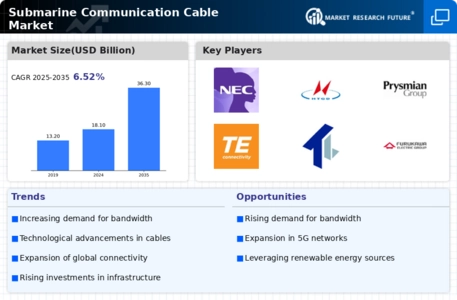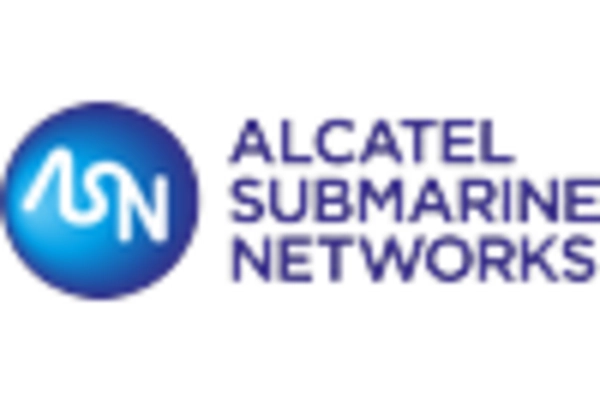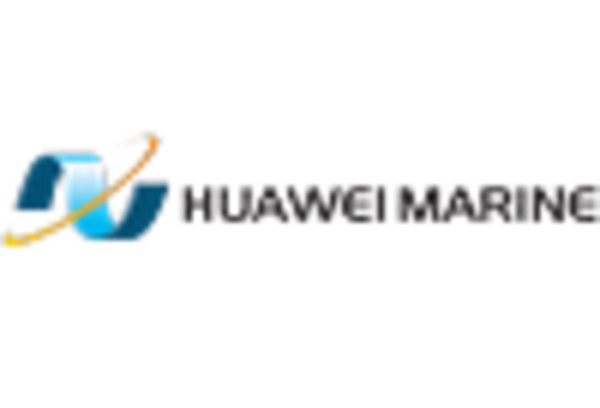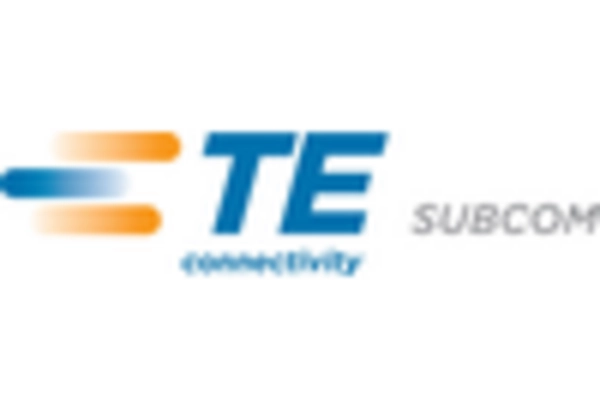Expansion of Data Centers
The expansion of data centers is a pivotal driver for the Submarine Communication Cable Market. As organizations increasingly migrate to cloud-based solutions, the need for interconnected data centers has intensified. This trend is reflected in the construction of new data centers in various regions, which often necessitates the deployment of submarine cables to ensure seamless connectivity. According to industry reports, the number of data centers is expected to grow significantly, leading to a corresponding increase in demand for submarine cables. This expansion not only supports the growing volume of data traffic but also enhances redundancy and reliability in data transmission, making submarine cables an essential component of modern digital infrastructure.
Emergence of 5G Technology
The rollout of 5G technology is poised to revolutionize telecommunications, creating new opportunities for the Submarine Communication Cable Market. With its promise of ultra-fast data speeds and low latency, 5G is expected to drive a substantial increase in data traffic. This surge in demand for bandwidth will likely necessitate the deployment of additional submarine cables to support the infrastructure required for 5G networks. As mobile operators and service providers invest in expanding their networks, the submarine cable market may witness a significant uptick in projects aimed at enhancing connectivity. The integration of 5G technology could also lead to innovative applications, further driving the need for robust submarine communication systems.
Increasing Demand for High-Speed Internet
The demand for high-speed internet continues to surge, driven by the proliferation of digital services and the growing reliance on cloud computing. This trend is particularly evident in regions where internet penetration is still developing. The Submarine Communication Cable Market is experiencing a notable increase in investments to enhance bandwidth capacity, with projections indicating that the market could reach a valuation of several billion dollars by 2026. As more consumers and businesses seek reliable and fast internet connections, the need for advanced submarine cables becomes increasingly critical. This demand is further fueled by the rise of streaming services, online gaming, and remote work, all of which require robust and efficient data transmission capabilities.
Geopolitical Tensions and Strategic Investments
Geopolitical tensions have a profound impact on the Submarine Communication Cable Market, as nations seek to secure their communication infrastructure. Countries are increasingly investing in submarine cable projects to enhance their strategic capabilities and ensure data sovereignty. This trend is particularly evident in regions where geopolitical rivalries are intensifying, prompting governments to prioritize the development of independent communication networks. Investments in submarine cables not only bolster national security but also facilitate economic growth by improving connectivity. As nations recognize the importance of resilient communication systems, the submarine cable market is likely to see increased funding and support from both public and private sectors.
Focus on Sustainability and Environmental Considerations
The focus on sustainability is becoming increasingly relevant in the Submarine Communication Cable Market. As environmental concerns grow, companies are exploring eco-friendly practices in the deployment and maintenance of submarine cables. This includes the use of sustainable materials and technologies that minimize ecological impact. Additionally, regulatory frameworks are evolving to encourage environmentally responsible practices in the telecommunications sector. The market may witness a shift towards more sustainable cable solutions, which could enhance the appeal of submarine cables to environmentally conscious investors and consumers. This emphasis on sustainability not only addresses regulatory pressures but also aligns with the broader trend of corporate responsibility in the telecommunications industry.

















Leave a Comment